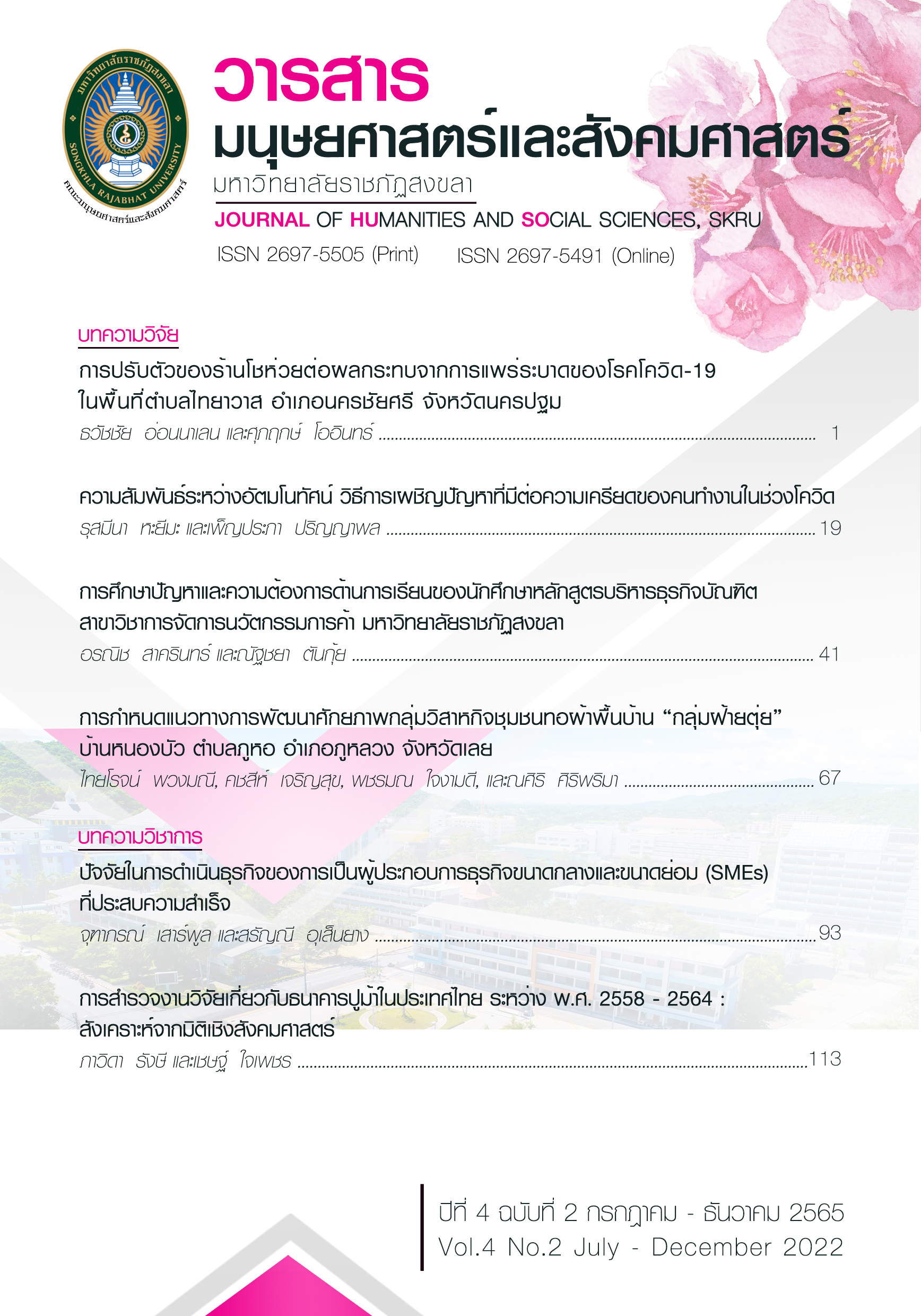INSTRUCTIONAL PROBLEMS AND NEEDS IN BUSINESS ADMINISTRATION PROGRAM, TRADING INNOVATION MANAGEMENT STUDENTS, SONGKHLA RAJABHAT UNIVERSITY
Main Article Content
Abstract
These research objectives are to study 1. Problems of students in Business Administration Program, Trading Innovation Management Major, Songkhla Rajabhat University 2. Needs of students in Business Administration Program, Trading Innovation Management Major, Songkhla Rajabhat University. It is a quantitative research by using semi-structured interview and open-ended question. The population and sample are 27 students from first generation in Trading Innovation Management Major, Songkhla Rajabhat University. The results found that students’ problems are divided to 3 parts are (1) Students’ basic information such as subject proficiency and necessary of family support (2) Study in the institution for example, short Program and no break should speed up work. (3) Skill training in the companies such as different training contents that make student confusion and companies’ distance. Next, Needs are separated to 2 parts are (1) Studying such as Program extension and study tool: computer, notebook and tablet. (2) Train intention such as teaching with intention of trainees and community location that is easy to go working.
Downloads
Article Details

This work is licensed under a Creative Commons Attribution-NonCommercial-NoDerivatives 4.0 International License.
ลิขสิทธิ
References
ดิเรก วรรณเศียร. (2560). MACRO model : รูปแบบการจัดการเรียนรู้สำหรับศตวรรษที่ 21. สืบค้นเมื่อ 10 มกราคม 2563, จาก https://regis.dusit.ac.th
ปานทิพย์ เรืองอร่าม. (2551). ศึกษาปัญหาการเรียนของนักศึกษาระดับปริญญาตรี คณะบริหารธุรกิจ มหาวิทยาลัยเทคโนโลยีราชมงคลรัตนโกสินทร์วิทยาเขตวังไกลกังวล. สารนิพนธ์ปริญญาการศึกษามหาบัณฑิต สาขาวิชาธุรกิจ มหาวิทยาลัยศรีนครินทรวิโรฒ. จาก http://thesis.swu.ac.th
ปานเพชร ชนินทร และวิเชษฐ์ พลายมาศ. (2553). ปัจจัยความสำเร็จของการจัดการศึกษาเชิงบูรณาการกับการทำงานสำหรับอุดมศึกษาไทย. การประชุมวิชาการ มหาวิทยาลัยเกษตรศาสตร์ วิทยาเขตกำแพงแสน ครั้งที่ 7. (1056-1063). กรุงเทพฯ: สำนักหอสมุดมหาวิทยาลัยเกษตรศาสตร์.
วิชัย ประสิทธ์วุฒิเวชช์. (2542). การพัฒนาหลักสูตรท้องถิ่น: สานต่อที่ท้องถิ่น. กรุงเทพฯ: เซ็นเตอร์ดิสคัฟเวอรี่.
ศุภิสรา สุวรรณชาติ และวิไลพร รังควัต. (2555). ปัญหาและความต้องการด้านการเรียนของนักศึกษาโครงการผลิตพยาบาลวิชาชีพเพิ่มเพื่อแก้ไขปัญหาในพื้นที่จังหวัดชายแดนภาคใต้. วารสารวิทยาลัยพยาบาลบรมราชชนนี นครราชสีมา. 18(2), 20-33.
สุมน อมรวิวัฒน์. (2535). การจัดการเรียนร้แบบเผชิญสถานการณ์. กรุงเทพฯ: ห้างหุ้นส่วนจำกัด.
สุมาลี จันทร์ชะลอ และเบญจมาภรณ์ จันทร. (2562). การจัดการศึกษาในระบบฝึกทวิภาคีในยุค 4.0. วารสารนวัตกรรมและเทคโนโลยีเพื่อการเรียนรู้. 2(1), 12-27.
สำนักงานเลขาธิการสภาการศึกษา. (2552). ข้ อเสนอการปฏิรูปการศึกษาในทศวรรษที่สอง (พ.ศ. 2552 - 2561). กรุงเทพฯ: พริกหวานกราฟฟิค.
ฮิวจ์ เดลานี. (2562). การศึกษาสำหรับศตวรรษที่ 21. สืบค้นเมื่อ 20 กันยายน 2562, จาก https://www.unicef.org/Thailand
Bloom, et al. (1956). The Function of Excutive. London: Oxford University Press.
Bower, H., and Hilgard, E. R. (1981). Theories of learning. (5th ed.). Englewood Cliffs, New Jersey: Prentice - Hall.
Cooper, L., Orrell, J., and Bowden, M. (2010). Work Integrated Learning: A guide to Effective Practice. New York: Routledge Taylor & Francis Group.
Dollard, J., and Miller, N. E. (1950). Personality and Psychotherapy : An Analysis in Term of Learning Thinking and Culture. New York: McGraw-Hill.
Haring, N. G., and Phillips, E. L. (1972). Analysis and Modification of Classroom Behavior: How to achieve skill in managing behavior and provide effective instruction for all children in the classroom. New York: Prentice-Hall.
Hough, B., and Duncan, K. (1970). Teaching description and analysis. Addison-Westlu.
Joyce, B., Weil, M., and Showers, B. (1992). Model of teaching. (4th ed.). Boston: Allyn and Bacon: A Divison of Simon & Schuster, Inc.
Keeves, P. J. (1997). Educational Research Methodology and Measurement : An International Handbook. Oxford, England: Pergamon Press.
Kimble. (1961). Hilgard and Marquis Conditioning and Learning. New York: Appleton-Century-Crofts.
Kramer. M., and Usher, A. (2011). Work-Integrated Learning and Career-Ready Students: Examining the Evidence: Higher Education Strategy Associates Intelligence Brief 5.
Martin, A., and Hughes, H. (2009). How to Make the Most of Work Integrated Learning: A Guide for Students, Lecturers & Supervisors. Palmerston North, New Zealand: Massey University.
Saylor, J. G, William M., and Lewis, A. J. (1981). Curriculum Planing for Better teaching and learning (4th ed.). New York: Holt, Rinehart & Winston.
Stirling, A., et al. (2016). A Practical Guide for Work Integrated Learning: Effective Practices to Enhance the Educational Quality of Structured Work Experiences offered Through Colleges and Universities. Ontario, Canada: Higher Education Quality Council of Ontario.


